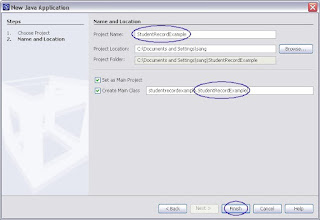
Introduction:
So far, you have dealt with a single class that contains main(..) method. In this exercise, you are going to create mulitple classes among which one class invokes another class - more precisely, a method in a class invokes a method of another class.
* If you are new to Object-Oriented Programming concept, please read "Object Oriented Programming Concept" section of the Java Programming Tutorial.
* If you are new on how to create a class, please see "Creating Class" section of Java Programmng Tutorial.
Steps to follow:
1. Write StudentRecord.java as shown in Code-10.1.a below. Please note that each *.java file contains a single Java class. (You are welcome to do this work using either command line tools or NetBeans. The instruction for using NetBeans is given below.)
* cd \myjavaprograms
* jedit StudentRecord.java
public class StudentRecord {
// Declare instance variables.
private String name;
private double mathGrade;
private double englishGrade;
private double scienceGrade;
private double average;
// Declare static variables.
private static int studentCount = 0;
/**
* Returns the name of the student
*/
public String getName(){
return name;
}
/**
* Changes the name of the student
*/
public void setName(String temp ){
name =temp;
}
/**
* Computes the average of the english,math and science
* grades
*/
public double getAverage(){
double result =0;
result =(mathGrade+englishGrade+scienceGrade )/3;
return result;
}
/**
* Returns the number of instances of StudentRecords
*/
public static int getStudentCount(){
return studentCount;
}
/**
* Returns the number of instances of StudentRecords
*/
public static void increaseStudentCount(){
studentCount++;
}
}
Code-10.1.a: StudentRecord.java
2. Write StudentRecordExample.java as shown in Code-10.1.b below.
* cd \myjavaprograms (if you are not in this directory already)
* jedit StudentRecordExample.java
public class StudentRecordExample{
public static void main(String [] args ){
// Create an object instance of StudentRecord class.
StudentRecord annaRecord =new StudentRecord();
// Increament the studentCount by invoking a static method.
StudentRecord.increaseStudentCount();
// Create another object instance of StudentRecord class.
StudentRecord beahRecord =new StudentRecord();
// Increament the studentCount by invoking a static method.
StudentRecord.increaseStudentCount();
// Create the 3rd object instance of StudentRecord class.
StudentRecord crisRecord =new StudentRecord();
// Increament the studentCount by invoking a static method.
StudentRecord.increaseStudentCount();
// Set the names of the students.
annaRecord.setName("Anna");
beahRecord.setName("Beah");
crisRecord.setName("Cris");
// Print anna's name.
System.out.println(annaRecord.getName());
// Print number of students.
System.out.println("Student Count = "+StudentRecord.getStudentCount());
}
}
Code-10.1.b: StudentRecordExample.java
3. Compile and run the code
* javac StudentRecord.java StudentRecordExample.java (or javac Student*.java or javac *.java)
* java -classpath . StudentRecordExample
4. Verify the result
* C:\myjavaprograms1>java -classpath . StudentRecordExample
Anna
Student Count = 3
Steps to follow if you are using NetBeans
1. Start the NetBeans IDE (if you have not done so yet)
* Windows: Start > All Programs > NetBeans 5.0 > NetBeans IDE or click NetBeans IDE 5.0 desktop icon.
* Solaris/Linux:
2. Create a new NetBeans project and StudentRecordExample main class
* Select File from the menu bar and select New Project.
* Under Choose Project, select General and Java Application
* Click Next.
* Under Name and Location pane, (Figure-10.1.d below)
o For Project Name field, fill it with StudentRecordExample
o For Create Main Class field, change it to studentrecordexample.StudentRecordExample (from studentrecordexample.Main) - You are creating StudentRecordExample class under studentrecordexample package.
o Click Finish
3. Modify the NetBeans generated code
* Replace the NetBeans generated StudentRecordExample.java code in the source editor with the one of Code-10.1.b above (not Code-10.1.a) while leaving the package studentrecordexample; statement on the top.
o You will see NetBeans generates some compile errors indicating it cannot find StudentRecord class. This is what is expected since you have not written StudentRecord class yet,
4. Write StudentRecord.java
* Right click StudentRecordExample project node and select New->Java Class. The New Java Class window appears.
* Under Name and Location pane,
o for Class Name field, type StudentRecord
o for Package field, choose studentrecordexample from the drop-down menu (or you can type studentrecordexample) - You are creating StudentRecord class under studentrecordexample package.
o Click Finish
5. Modify the NetBeans generated code
* Replace the NetBeans generated StudentRecord.java code in the source editor with the one of Code-10.1.a above while leaving the package studentrecordexample; statement on the top.
6. Run StudentRecordExample application
* Right click StudentRecordExample project node and select Run Project.
* Note that the Output window displays the result
No comments:
Post a Comment